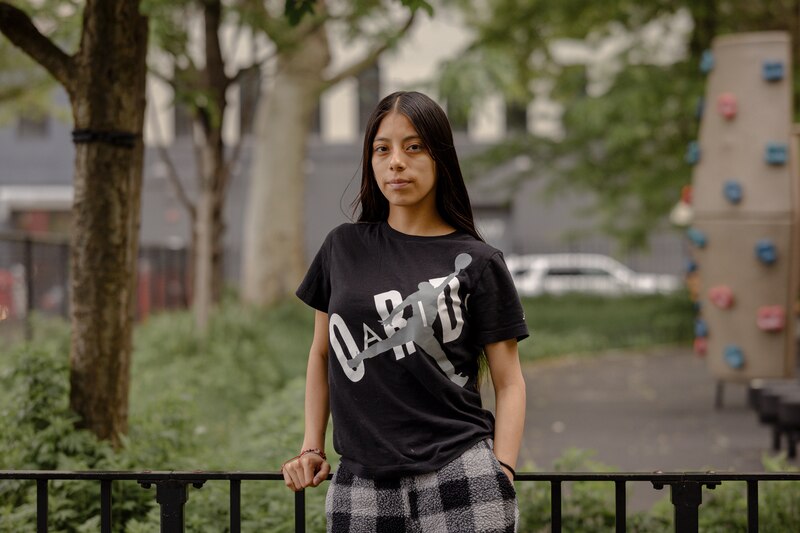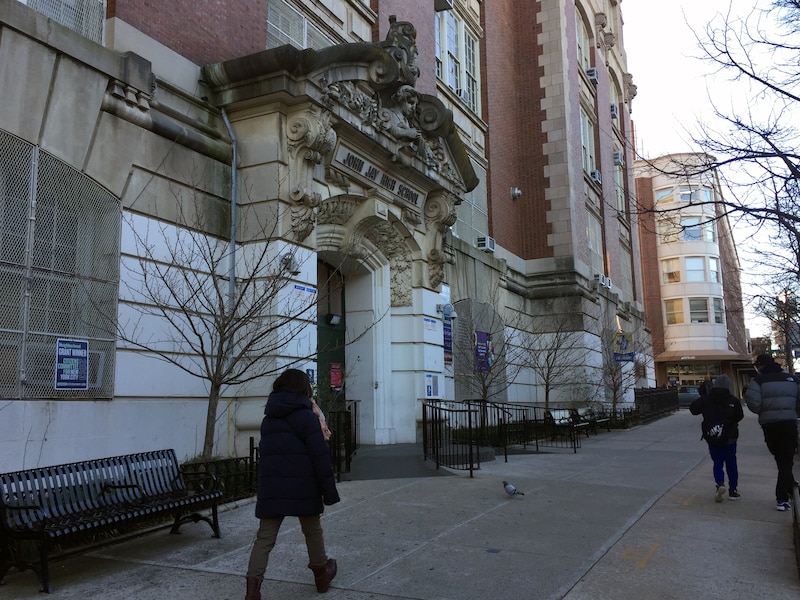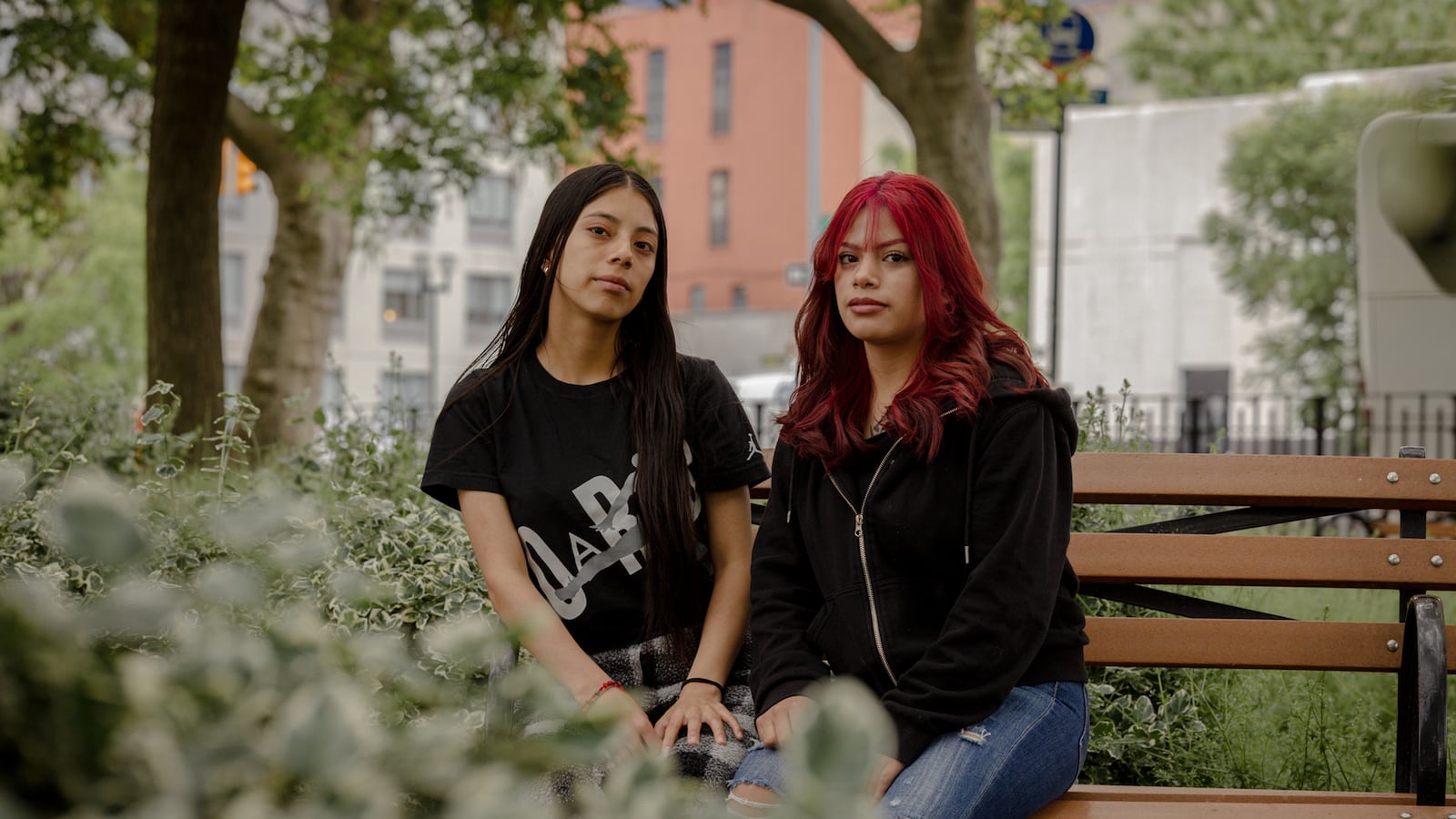Genesis Callero thought she was nearing the finish line.
The 18-year-old senior had made quick academic progress since arriving at the Cyberarts Studio Academy in Park Slope, Brooklyn — CASA, for short — from Ecuador last year knowing no English. She had passed four of her five required Regents exams and earned more than enough credits to graduate, according to Genesis and a school staffer familiar with her transcript.
All that remained was the English Language Arts Regents exam, the only Regents test newly arrived immigrants aren’t eligible to take in their home language. Students learning English as a new language often need extra time and support to pass, according to educators. Still, Genesis was optimistic that she would get her diploma this school year and had even taken a professional graduation portrait.

So the teen was blindsided when school officials, including principal Valrie Wauchope, summoned her to a meeting just over two months ago and delivered devastating news.
Neither Genesis nor her sister Karen, 17 and also a senior, would be able to graduate from CASA, Genesis recalled the school officials saying. They told the girls they would need to transfer and recommended New Dawn Charter High School, a transfer school geared toward older students at risk of not graduating.
“They told me no, they can’t help me in this high school,” Genesis said in Spanish, recalling her meeting with CASA officials. “It seemed to me like something unfair.”
The family felt they had no choice but to transfer. Within days, Genesis and Karen left CASA.
The teens were not alone. According to interviews with the families of six immigrant students from CASA — all seniors who had recently failed the ELA Regents exam, according to families and staffers — Wauchope recently told their children they would not graduate if they remained at CASA and counseled them to transfer immediately.
“If he stays, he won’t graduate,” the mom of another 17-year-old senior at CASA told Chalkbeat in Spanish, recalling what the principal told her. The mom asked to remain anonymous because she fears jeopardizing an active immigration case.

All of the families have since taken their children out of CASA, according to interviews and school records obtained by Chalkbeat.
Wauchope, who is in her first year as principal at CASA, didn’t respond to phone calls or an email seeking comment. Education Department spokesperson Chyann Tull said, “We take allegations of students being pushed out of their school very seriously and investigate all formal complaints when they arise. Every student has the right to remain in their school through graduation and be immersed in a supportive learning environment.” Tull didn’t immediately say whether the department has received complaints about CASA.
Three staffers at the school, who spoke on the condition of anonymity for fear of retribution, contend the students would have been able to graduate from CASA with more time. Immigrant students often fail the ELA Regents exam on their first attempt but can pass with extra time and support. Just 27% of city English language learners passed the ELA Regents in 2023, according to state data. Under New York law, students can remain in school through the academic year they start at age 21.
The staffers suspect students were pressured to transfer because if they did not graduate this school year, it would harm the school’s four-year graduation rate — a key performance measure for city principals. CASA’s four-year June graduation rate in 2023 was 75% last year, lower than the 81% citywide average.

“They’re our best students. They come to school every single day, pass their other Regents exams,” said one staffer, adding that some students are homeless and haven’t been in the country long. “This is all because they can’t pass their English Regents on time. To push them out … it’s disgraceful.”
The staffers said they worry the situation will continue with future students learning English as a new language.
Annette Renaud, a longtime parent activist and former CASA Parent Association president who remains involved at the school supporting several relatives enrolled there, said she reached out to some of the families of immigrant students after learning about the situation from staff. She’s hoping the students can be reenrolled at CASA.
“I don’t know how many doctors, lawyers, sanitation supervisors, home attendants … we pushed out the door.”
Graduation pressures weigh on administrators
Several school administrators from across New York City told Chalkbeat that high school principals often face intense pressure to improve their four-year graduation rates. That pressure can be particularly acute for schools like CASA that have absorbed large numbers of newly arrived immigrant students amid the influx of roughly 36,000 migrant students over the past two school years.
CASA’s population of English Language Learners surged from below 40 in 2018 to nearly 100 out of its 300 students last year, according to city data. English Language Learners often take longer to graduate and finish high school at lower rates than their peers.
For English Language Learners who began high school in 2017, roughly 56% graduated in four years, jumping to 67% in six years.
That’s compared to 80% of all students in the 2017 cohort who graduated within four years and 87% within six years.
In recent years, “schools that have never really seen a high population of immigrant students were suddenly seeing these populations, and there were some growing pains there,” said Liza Schwartzwald, Director of Economic Justice and Family Empowerment at the New York Immigration Coalition, an advocacy organization.
But she stressed that “it is still incumbent on the school” to seek out some of the many resources available to better support newcomer students.
The allegations at CASA represent an “egregious example of the wrong way to go about doing this work,” she said.

Schools have alternatives to help immigrant students
To be sure, some older teenagers still learning English may benefit from a school more specifically tailored toward serving older newcomer students, particularly if they are in danger of aging out of the system and severely behind on credits, educators and advocates said.
But that wasn’t the situation for students counseled to transfer out of CASA, all of whom were 19 or younger, had passed at least some of their other Regents exams, and had accumulated all or close to all the credits they needed to graduate, according to staff and families.
Educators said that the school, which has hired several English as a new language teachers in recent years, was more than capable of shepherding the students to passing the ELA exam. They just needed a little more time.
“We would be able to get them to that passing rate within that time 100%,” said one CASA staffer. “No doubt in my mind.”
Schools have other avenues for supporting immigrant students struggling with the ELA Regents that don’t involve forcing them to transfer, said Rita Rodriguez-Engberg, the Immigrant Students Rights Project Director at Advocates for Children, a nonprofit that works on behalf of vulnerable kids.
They can refer students to extra night classes at Young Adult Borough Centers without un-enrolling them, and there is an appeals process specifically for the ELA Regents test for English Language Learners who fail the exam but score close enough to the cutoff.
“There are several options,” Rodriguez-Engberg said. “You don’t just ask a student to leave.”
Families struggle with fallout of being pushed out
The immigrant students who left CASA had different backgrounds and academic profiles, but all of them were making progress at the school and none wanted to abruptly leave in the spring of their senior year, according to interviews with the students and their families and records reviewed by Chalkbeat.

One student, a 17-year-old recent arrival from Venezuela, quickly won admiration from staff and students since enrolling last fall for his gregarious demeanor and inspiring story, according to his family and staffers. The boy’s mom asked not to use his name because the family has an open immigration case.
On his most recent report card, issued around the time he left the school in March, he earned an 85% average and comments from teachers praising his “excellent progress,” “consistent participat[ion]” and “initiative,” according to a copy reviewed by Chalkbeat.
The teen recounted his grueling immigration journey in a student-produced film that played on TVs in the school’s main office and hallways, according to a video reviewed by Chalkbeat.
The family was devastated by the news he couldn’t remain at the school.
The boy’s mom said she asked Wauchope about alternatives that would allow her son to remain at CASA, like enrolling him in night classes for English or taking longer to graduate. Wauchope didn’t budge, and the mom agreed to withdraw her son.
“I felt it was something bad they did to him,” she said. But in the moment, she felt powerless. “Sometimes out of fear, we’re migrants, we don’t say no, we do what they say.”
That didn’t stop the woman from continuing to advocate for her son. She went back for a second meeting with Wauchope, telling the principal she thought the decision was unfair, she said.
She also visited an enrollment center and asked them to reenroll her son at CASA. She was told the school was now full and could not accept any more students, the mom said.
The boy was crushed but told his mom, “If it’s to graduate, it’s okay.”
He has since enrolled at New Dawn, but frequently drops by CASA to say hi to classmates and teachers.
“It hurt me very much because I see him now, he doesn’t want to go to class,” his mom said. “It destabilized him totally. It flipped his world upside down.”
The news landed just as hard for Carolina, a 19-year-old senior from Guatemala. Since arriving at CASA three years ago, she had made significant academic, social, and linguistic strides.
The teen, who asked to use only her middle name for fear of immigration consequences, struggled at first to acclimate to her new school and country.
“But after some time passed, I adapted. I understand and speak English,” she said.
Carolina’s attendance had faltered this year, and she still needed to pass two Regents exams, according to transcript information shared with Chalkbeat. But she was hopeful she would soon graduate and planned to apply to college or join the Army.
When Wauchope told Carolina she wouldn’t be able to graduate from CASA and counseled her to transfer in late February, the teen was crestfallen over the idea of leaving her home of three years.
“I couldn’t adapt to a new school or new people,” she recalled pleading in the meeting.
She and her mother begged for the chance to stay at the school, promising to redouble the teen’s efforts to pass the exam. But Wauchope held firm, according to the family. (One CASA staffer noted the teen is technically still on CASA’s roster, likely because she was never officially unenrolled. But Carolina’s mother said she wasn’t aware of that.)
Despite her misgivings, Carolina eventually decided to give New Dawn a try.
She set out for the school, which is a farther commute than she’s used to, on a Friday morning last month, and arrived after classes had begun, according to the teen and her mom. While Sara Asmussen, New Dawn’s founder and executive director, said the school “accepts students year-round with no intake requirements at all,” Carolina said staff at the school asked her, in English, to come back on Monday.
Carolina never went back. She hasn’t returned to that school, or any other, since.
Michael Elsen-Rooney is a reporter for Chalkbeat New York, covering NYC public schools. Contact Michael at melsen-rooney@chalkbeat.org.

